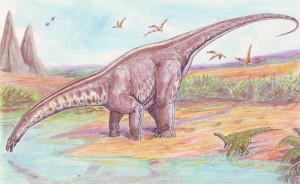Here’s something the builders of Jurassic Park didn’t take into consideration: dinosaur farts.
The tremendous emissions of creatures like Apatosaurus—think raunchy volcanoes on legs—may have warmed the Earth at a time when it was already extremely balmy.
Scientists estimate that plant-eating sauropods—the most likely offenders during the Mesozoic era—could have produced 520 million tons of the greenhouse gas methane a year. This is roughly on par with the amount churned out by all natural and man-made sources today.
The Mesozoic era, which included the Jurassic period in its middle, lasted from 250 million years ago until 65 million years ago, when the dinosaurs died out. It’s often known as the Age of Reptiles, although a more accurate title would be the Gaseous Era.
While every dinosaur in Jurassic Park probably passed gas once in a while, few could rival the voluminous explosions of Brachiosaurus and Apatosaurus. Like cows, camels, and other ruminants, the stomachs of the sauropods were probably filled with bacteria that helped them digest the fibrous plants they ate throughout the day.
Without a time machine—and a very large jar to capture the dinosaur farts—it’s impossible to know exactly how much methane the sauropods released. Flatulence also doesn’t fossilize well, although you might find some curious impressions left behind in the mud after a rear-end explosion.
Scientists, though, did their best to compensate for the lack of direct evidence by estimating sauropod methane production the old-fashioned way—with dinosaur math.
- Sauropods have similar digestive systems and gut microbes to today’s ruminants. By taking the methane production of cows (measured, I assume, with some sort of gas-collecting cow diaper), you can estimate how much gas a sauropod could pass (if a sauropod could pass gas).
- If 10 sauropods, weighing 20,000 pounds each, live together in 1 square kilometer of lush, plant-rich Mesozoic habitat, then how many tons of methane would they produce a year? 7.6 tons
- If 50 percent of the Earth’s surface was hospital to sauropods during the Mesozoic period, then how many tons of methane would the entire Sauropodian Empire produce in a year? 550 million tons
This is a lot. Even the researchers were shocked.
“I was expecting a number like that produced by cows, so the size of the number really surprised me,” David Wilkinson of Liverpool John Moores University in the United Kingdom told Discovery News. “It’s way, way, way ahead of the estimated methane production by modern livestock.”
In comparison, cows produce 55 to 110 million tons of methane a year (another reason for cow diapers).
The sauropods, however, had many things going for them, in terms of fodder for flatulence.
- They were large creatures, with long necks, meaning they could reach high, low, and wide for tasty, gas-producing plants.
- The climate was much warmer during the Mesozoic era, so the sauropods had much more vegetation to feast on.
- Sauropods were organic, free-range dinosaurs, and could wander about, eating leaves and branches, and farting as they pleased.
Did all this farting alter the climate? Methane, even though it is naturally produced, is a very potent greenhouse gas. If Wilkinson’s dinosaur math is correct, the sauropods could have made the Mesozoic warmer and wetter (and raunchier) than today.
Something to think about next time you want to genetically engineer a dinosaur for your remote island.
__________
Reference: Wilkinson, D., Nisbet, E., & Ruxton, G. (2012). Could methane produced by sauropod dinosaurs have helped drive Mesozoic climate warmth? Current Biology, 22 (9) DOI: 10.1016/j.cub.2012.03.042
Photo by Wikipedia Commons



